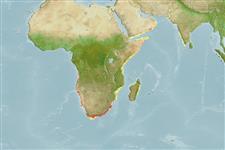>
Eupercaria/misc (Various families in series Eupercaria) >
Sparidae (Porgies)
Etymology: Sparodon: Latin, sparus = a fish with a golden head + Greek, odous = teeth (Ref. 45335).
More on author: Castelnau.
Environment: milieu / climate zone / depth range / distribution range
Ökologie
seewasser demersal; tiefenbereich 0 - 80 m. Tropical
Southeast Atlantic: Cape of Good Hope to Natal in South Africa. Also recorded from Djibouti (Ref. 5450) and from Mozambique (Ref. 5213).
Length at first maturity / Size / Gewicht / Alter
Maturity: Lm 35.0 range ? - ? cm
Max length : 120 cm TL Männchen/unbestimmt; (Ref. 3507); common length : 70.0 cm TL Männchen/unbestimmt; (Ref. 3507)
Rückenflossenstacheln (insgesamt): 11; Rückenflossenweichstrahlen (insgesamt): 11-12; Afterflossenstacheln 3; Afterflossenweichstrahlen: 10. Faint stripes on a greyish body; bluish glow while in water (Ref. 3198).
Inhabits shallow coastal waters, mainly off rocky shores down to 80 m depth. Rarely enters estuaries. Young commonly found in tide pools. Feeds mainly on mollusks (Ref. 5213). An important food fish.
Life cycle and mating behavior
Geschlechtsreife | Fortpflanzung | Ablaichen | Eier | Fecundity | Larven
Smith, J.L.B. and M.M. Smith, 1986. Sparidae. p. 580-594. In M.M. Smith and P.C. Heemstra (eds.) Smiths' sea fishes. Springer-Verlag, Berlin. (Ref. 3198)
IUCN Rote Liste Status (Ref. 130435)
Bedrohung für Menschen
Harmless
Nutzung durch Menschen
Fischereien: kommerziell; Sportfisch: ja
Mehr Information
ReferenzenAquakulturAquakultur ProfilZuchtlinienGenetikElectrophoresesVererbbarkeitKrankheitenVerarbeitungNutrientsMass conversion
PartnerBilderStamps, Coins Misc.LauteCiguateraGeschwindigkeitSchwimmstilKiemenoberflächeOtolithsGehirngrößeSehfähigkeit
Tools
Zusatzinformationen
Download XML
Internet Quellen
Estimates based on models
Preferred temperature (Ref.
123201): 18.1 - 28.3, mean 26.8 °C (based on 204 cells).
Phylogenetic diversity index (Ref.
82804): PD
50 = 1.0000 [Uniqueness, from 0.5 = low to 2.0 = high].
Bayesian length-weight: a=0.01738 (0.00993 - 0.03041), b=2.94 (2.79 - 3.09), in cm total length, based on LWR estimates for this species & (Sub)family-body (Ref.
93245).
Trophic level (Ref.
69278): 3.8 ±0.0 se; based on diet studies.
Generation time: 9.5 ( na - na) years. Estimated as median ln(3)/K based on 1
growth studies.
Widerstandsfähigkeit (Ref.
120179): niedrig, Verdopplung der Population dauert 4,5 - 14 Jahre. (K=0.09; tm=5.4; tmax=26).
Fishing Vulnerability (Ref.
59153): High vulnerability (63 of 100).
Nutrients (Ref.
124155): Calcium = 66.4 [30.6, 127.4] mg/100g; Iron = 0.833 [0.443, 1.716] mg/100g; Protein = 18.8 [17.5, 20.0] %; Omega3 = 0.163 [0.088, 0.305] g/100g; Selenium = 73.3 [31.7, 157.9] μg/100g; VitaminA = 8.41 [2.11, 31.18] μg/100g; Zinc = 0.728 [0.474, 1.094] mg/100g (wet weight);
